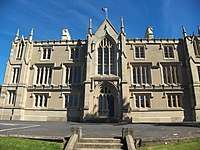Institute for Marine and Antarctic Studies
The Institute for Marine and Antarctic Studies (IMAS) is a teaching and research institute of the University of Tasmania in Hobart, Tasmania. IMAS was established in 2010 building upon the university's partnership with CSIRO Oceans and Atmosphere and the Australian Antarctic Division in cooperative Antarctic research and Southern Ocean research.[1]
 | |
| Type | Public |
|---|---|
| Established | 2009 |
| Chairman | Mary O’Kane |
| Chancellor | Michael Field AC |
| Vice-Chancellor | Rufus Black |
| Director | Richard Coleman |
| Location | Hobart , , |
| Nickname | IMAS |
| Affiliations | University of Tasmania |
| Website | www.imas.utas.edu.au |
Marine geophysicist Prof Mike Coffin was appointed founding Executive Director of IMAS in 2010. Prof Richard Coleman, an oceanographer and cryospheric scientist, was appointed Executive Director of IMAS in July 2015. Terry Bailey has been the Executive Director since July 2019.
Mission statement
“To improve understanding of temperate marine, Southern Ocean, and Antarctic environments, their resources, and their roles in the global climate system through research, education, and outreach”.[1]
Research themes
The Institute takes a multidisciplinary, whole-system approach to research, education, and outreach. IMAS was established with a core research and education capability, initially consisting of significant and internationally recognised expertise in the following foundation themes:[1]
- Oceans and cryosphere
- Fisheries and aquaculture
- Ecology and biodiversity
These programs are linked by three key cross-disciplinary themes to meet integrative and multidisciplinary research goals:
- Climate change
- Ocean-Earth system
- Ocean and Antarctic governance
Excellence in Research Australia
The Australian Research Council's (ARC) Excellence in Research for Australia (ERA) initiatives provide a specific benchmark for the core IMAS disciplines of oceanography and fisheries sciences, and in 2012 IMAS strongly contributed to the University of Tasmania achieving grade 5 scores (well above world standard) in oceanography, ecology, and geology, and in fisheries sciences.[2]
Infrastructure

A new ~69,000 m² building on the Hobart waterfront was completed in 2013, to co-locate IMAS, Australia's Integrated Marine Observing System (IMOS), the Antarctic Climate and Ecosystems Cooperative Research Centre (ACE CRC), and the Tasmanian Partnership for Advanced Computing (TPAC) staff and students. The new building, adjacent to CSIRO, will create an exceptional research and educational environment supported by state-of-the-art technology, and will serve as a hub for collaborative marine and Antarctic studies. The project is an initiative of the Australian Government as part of the Education Investment Fund.[3]
Planning is under way for existing research and educational infrastructure totalling ~4,500 m2 south of Hobart at Taroona to be significantly expanded with new aquaculture and controlled-environment experimental saltwater facilities. Planned new capabilities include temperate/polar ocean simulations, and greatly enhanced aquaculture research.[1][4]
Partnerships
- Australian Antarctic Division
- Antarctic Climate and Ecosystems Co-operative Research Centre (to be co-located with IMAS)
- CSIRO Marine and Atmospheric Research
- Integrated Marine Observing System (to be co-located with IMAS)
- Tasmanian Partnership in Advanced Computing (to be co-located with IMAS)
- National Centre for Marine Conservation and Resource Sustainability at the AMC (NCMCRS),
- Faculty of Science, Engineering and Technology, University of Tasmania
- Network of Aquaculture Centres in Asia-Pacific
External links
References
- Archived 5 November 2013 at the Wayback Machine, IMAS Strategic Plan 2012-2017
- , Excellence in Research Australia Initiative
- , Australian Government Education Investment Fund Round 2 Information
- , $5 million for new UTAS centres a 'step change' in research
